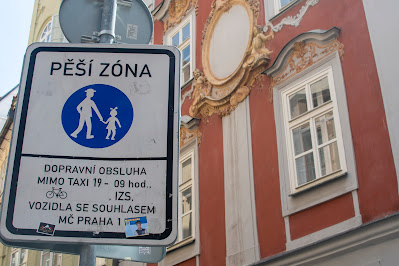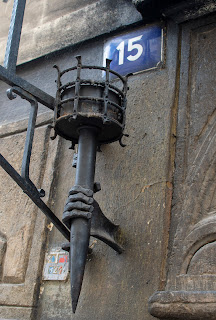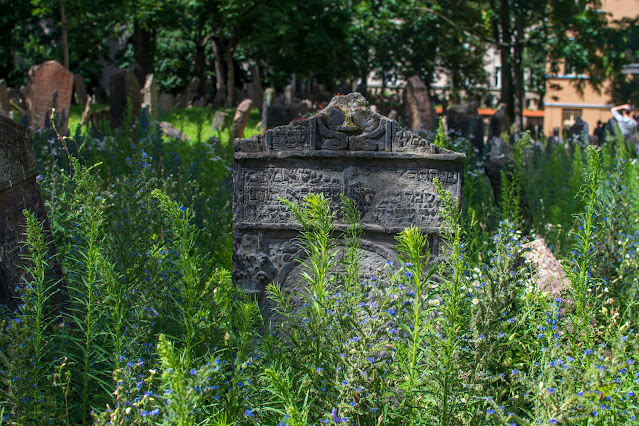Day two of our central European adventure dawned bright and early, with little in the way of sleep, the overnight temperature seemingly not having budged from the mid twenties. Ordinarily, on such little sleep, I would be seeing pink elephants walking through warping walls, but surrounded by so much beauty, adrenalin over-rode any temptation to sleep in.
Today's plans were to visit Prague Castle and the Jewish Cemetery. Maury had advised us to buy a transport pass, enabling us to hop on and off the trams - specifically the number 22 tram - to ensure that the only walking we did was down hill. However well intended Maury's advice was, we smiled politely, knowing full well that it would be completely ignored. Half the fun for us is exploring on foot and occasionally deviating from our planned route if another view glimpsed at the end of an alleyway captivates us.
So, after breakfasting on water melon, toasted Czech bread (lightly spiced?) and coffee, we headed out, plastered in sun cream.
Shafts of light found there way through gaps between the tall buildings and lamp posts, casting golden light on the pavements.
In no time at all, a glimpse of the impressive castle complex.
Charles Bridge was already starting to get busy and so I snapped photos whenever there was an opportune moment and a lucky pause in visitors passing through my camera frame. Charles Bridge makes for an interesting walk where musicians, traders and saints vie for tourists' attention.
 |
| Caricatures under the watchful gaze of Saints Barbara, Margaret and Elizabeth. |
 |
| Monument of the crucifixion of Jesus. |
 |
| Busking Musicians |
 |
| John the Baptist |
 |
| Skull detail on the statue of St Francis Borgia (Spanish Jesuit Priest) |
This statue below, of John of Matha, Felix of Vaois and Saint Ivan had an interesting detail. Forgive the angle here, but I liked the antlers and it was initially impossible to get closer without being photo bombed. Unsurprising really, given that it is the most expensive and spacious sculpture, designed in 1714 by Ferdinand Brokoff. The sculpture was intended to honour the two founders of the Trinitarians, the order that supervised buying back and redeeming of Christians in captivity of non believers.
Finally!
The base depicts a cave in which three chained Christians are praying to the Lord for salvation.
From the north side of the bridge, it was all up hill. We had been warned!
The shop signs seemed to grow increasingly elaborate....
...and the architectural details ever more beautiful.
Nothing, not even the single purpose humble bollard, is permitted to be utilitarian.
We passed on the opportunity to hop on this "train."
Finally, we reached the castle walls and stopped to take in the amazing views over the city.
Despite being advised to purchase tickets in advance, we walked straight to the kiosk and secured our tickets without any queue. In fact, the young assistant spotted Caleb and asked his age, prompting his colleague to sell us a student discount ticket without any proof of ID. We opted for the tour that included the Old Royal Palace, the Basilica of St George, Golden Lane and St Vitus Cathedral. Gareth and Caleb paid extra to go to the top of the tower at St Vitus Cathedral to see the country's largest bell, cast in 1549 and weighing a mere 15 tonnes. I stayed rooted to the spot and waved like a loon when they appeared at the top. Gareth is there, in the central opening at the top of the tower, but his shirt camouflaged with the stonework.
The detail and craftsmanship of the cathedral entrance were awe inspiring.
I also spotted this happy couple being photographed amongst the grandeur and crowds.
Back the business at hand. A few facts. Prague Castle is the largest castle complex in the world. Formerly the seat of the kings of Bohemia with 9th century origins, it is now the official residence of the President of the Czech Republic and is a UNESCO World Heritance Site. It is an aggregation of palaces, churches, offices fortifications, courtyards and gardens.
St George's Basilica is the oldest surviving building that is part of the palace complex. The first building of the castle was destroyed by fire in the 13th century. St George's was constructed in the early 10th century and consecrated in 921, making it the oldest Romanesque-style building in Prague too. Its distinctive red baroque facade (which I'm afraid I completely failed to photograph due to heady excitement) was added in the 17th century.
Here's a stock photo instead.
I have to say that travelling with a camera presents some issues. I opted to take a 35 mm lens on holiday (slightly wider angle, good in low light). However, the reality of visiting such magnificent destinations is that you have to consider others and also ensure that you take something of the moment for yourself, rather than constantly looking for the best angle or photo opportunity which can dilute the experience.
Inside St George's Basilica.
Whilst I'm glad we visited, there was no escaping the crowds. Obviously we're all entitled to see these sites, but I'm sometimes left with that feeling of having been "processed" hence this mere glimpse below of the stone vaulted ceiling in Vladislav Hall (1493-1502) in the Old Royal Palace, used for large public events, including coronations and even tournaments, captured as we shuffled around the perimeter.
The impressive gold eagle frame above, filtered light, drawer handle and the beautifully bound books of the court of justice of the Bohemian realm also caught my attention.
The majestic St Vitus Cathedral in all of its gothic glory was a sight to behold. To ensure this blog doesn't turn into a lengthy history lesson taking the rest of your day to complete, you can read all about it here at leisure.
One of the many stunning stained glass windows.
As the cathedral was rapidly filling up, we escaped to the relative calm of Golden Lane, a quaint and narrow row of houses originally housing castle artisans, including alchemists and herbalists...
...fortune tellers, seamstresses and candle stick makers.
In stark contrast to the grand symmetry of the castle's notable buildings, I loved the fairy tale aesthetic of these tiny properties with their wonky windows and low rooftops.
The writer Franz Kafka also lived and worked in one of these houses (number 22 I think) between 1916 and 1917. Evidence of the man and his work is everywhere in Prague and number 22 was no exception. I was half expecting to smell Kafka's aftershave lingering in the air upon entering this once creative space.
Check out the wallpaper!
A small cinema offered up a Kafka classic.
Passing the guards, I spotted one giving me the side eye as I was preparing to photograph him. Surely a break from protocol. Charles IV would have almost certainly had him thrown into the river for such behaviour!
We were, by now, starving and headed back down the hill from the castle, pausing outside a medieval tavern. It looked suitably dark and ghoulish from outside, with a row of skulls above the bar entrance, so in we went!
What a building!
As with all of the watering holes in Prague, the beer was cold and so refreshing.Determined to try as many traditional Czech dishes as I could, I perhaps unwisely opted for the pork knuckle, which was definitely one to share. Served with bread, grated horseradish, pickles and Dijon mustard, it was also the messiest dish I could have ordered, particularly as we were expected to eat with our fingers. The staff were also possessed by the ghosts of medieval serving staff, being somewhat abrupt; slamming down our beers and delivering the bill by sticking it to the table with the point of a knife. All part of the experience I think.
Vegetarians look away now!
Feeling as though I never want to allow another morsel of meat to pass my lips, we hot footed it to our next destination - the Jewish Quarter.
Until 1850, when Holy Roman Emperor Joseph II gave the city's Jewish citizens equal rights, the Jewish Quarter (or "Jewish Town") was known as the "Jewish ghetto."
The quarter was referred to as "Jewish" for the first time in 1096 and was founded after other Jewish settlements were destroyed in a pogrom.
Since 1215, the Jews were segregated from the Christian population and the area took on the character of a ghetto. In 1389 there was yet another pogrom during which a great many of the ghetto's inhabitants lost their lives and several more took place in the 15th and 16th century when the Jews were repeatedly banished from the country.
During World War II and that terrible chapter - particularly in Jewish history - the Quarter became a storage space for the Jewish population's confiscated property. Since a lot of this property stayed in the hands of the Jewish Quarter after the war because the original owners were murdered in concentration camps, the Jewish Museum became the second biggest in the world.
The number of Jewish residents has dropped significantly due to business use of the quarter and foreign travel expansion. By the end of 2013 there were only around 1400 residents.
The area is forever associated with the Golem of Prague Legend. In Jewish folklore, the superhuman Golem is a statue brought to life by a Rabbi (by inserting a clay tablet bearing the name "God" into his mouth). In return the Golem would offer protection to the community against hostile Christians. (We came back with a copy of the book of this tale).
The Old Jewish Cemetery is the most remarkable of its kind in Europe and was in use from the first half of the 15th century until the second half of the 18th century. There are around 12000 gravestones and when you consider that they were sometimes buried 12 deep, the number of graves is even higher.
I found this cemetery incredibly moving, but a tranquil haven in the midst of a bustling city. Here are just a few of the scores of photos I took of this place.
I overheard a tour guide stating that Jewish gravestones often include a little detail about the person resting beneath. Coincidentally, later that day, I read a tweet from Jewish UK comedian David Baddiel in which he detailed the inscription on his late father's grave. It referred to him as "sometimes grumpy" and ended with the words "almost human." David had been asked to expand on this and explained that it was a phrase his Dad would often use when asked how he was. When David and his brother asked "Almost human? Why not completely human?" he would respond "Because if I say I feel completely human, you bastards will ask me for money!" A sign of Jewish humour and resilience if ever there was one.
On our route back, we passed the Franz Kafka statue...
...before once again crossing Charles Bridge...this time, taking a different approach and the steps...
...and encountering more music and magic in the changing light.
Weaving back through the narrow cobbled streets, mostly behind this balloon seller...

...we opted to spend the rest of the evening relaxing in our apartment, wine and beers on chill and windows thrown open, taking in the sights and sounds in the streets below.








































































































